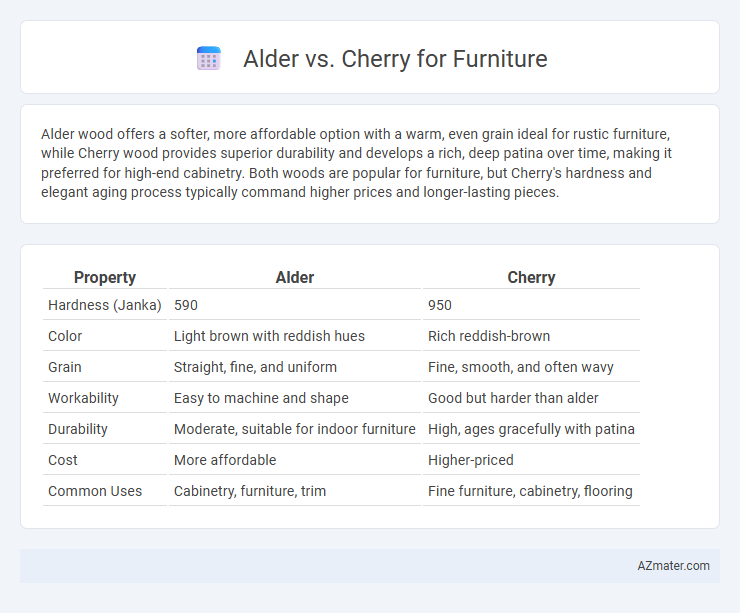Alder wood offers a softer, more affordable option with a warm, even grain ideal for rustic furniture, while Cherry wood provides superior durability and develops a rich, deep patina over time, making it preferred for high-end cabinetry. Both woods are popular for furniture, but Cherry's hardness and elegant aging process typically command higher prices and longer-lasting pieces.
Table of Comparison
| Property | Alder | Cherry |
|---|---|---|
| Hardness (Janka) | 590 | 950 |
| Color | Light brown with reddish hues | Rich reddish-brown |
| Grain | Straight, fine, and uniform | Fine, smooth, and often wavy |
| Workability | Easy to machine and shape | Good but harder than alder |
| Durability | Moderate, suitable for indoor furniture | High, ages gracefully with patina |
| Cost | More affordable | Higher-priced |
| Common Uses | Cabinetry, furniture, trim | Fine furniture, cabinetry, flooring |
Introduction to Alder and Cherry Wood
Alder wood, known for its consistent reddish-brown hues and fine grain, offers a softer, more pliable material favored for intricate furniture designs and smooth finishes. Cherry wood boasts a rich, warm tone that deepens with age, admired for its durability and elegant grain patterns ideal for high-end furniture pieces. Both woods provide distinct aesthetic and structural qualities that influence their suitability for various furniture styles.
Key Characteristics of Alder Wood
Alder wood, prized for furniture, features a fine, uniform texture with a smooth grain that often displays subtle cathedrals and curly patterns, making it highly suitable for staining and finishing. Its moderate hardness, rating 590 on the Janka scale, offers a balance between durability and ease of workability compared to the generally harder cherry wood. Alder's light reddish-brown hue deepens over time, enhancing its aesthetic appeal, while its consistent density provides stability against warping and shrinkage in furniture construction.
Key Characteristics of Cherry Wood
Cherry wood is prized for its rich, reddish-brown color that deepens beautifully over time, providing furniture with a warm and elegant appearance. Its fine, straight grain and smooth texture make it highly workable and capable of holding intricate details, while its natural resistance to warping and shrinking ensures durability. Compared to alder, cherry offers a higher density and hardness, contributing to more robust furniture pieces that maintain their aesthetic appeal even with frequent use.
Appearance and Color Comparison
Alder wood features a light brown to reddish hue with a fine, straight grain pattern, offering a warm, rustic aesthetic ideal for casual or traditional furniture styles. Cherry wood displays a rich, reddish-brown color that deepens over time, showcasing smooth grain and natural luster suited for elegant and formal furniture pieces. The distinct color evolution of cherry contrasts with alder's consistent tone, making cherry a preferred choice for designs requiring a rich, sophisticated look.
Durability and Hardness
Alder wood is softer and less durable than cherry, making it more prone to dents and scratches in high-traffic furniture applications. Cherry wood boasts a Janka hardness rating of around 950, providing greater resistance to wear and impact compared to alder's rating near 590. For long-lasting furniture that withstands daily use, cherry is preferable due to its superior hardness and durability.
Workability and Ease of Finishing
Alder wood offers excellent workability due to its soft texture, making it easier to cut, shape, and sand compared to Cherry, which is denser and harder. Cherry hardwood, while more challenging to work with, provides a smoother finish and develops a rich patina over time, enhancing its aesthetic appeal. Both woods take stains and finishes well, but Alder tends to absorb finishes more evenly, reducing the risk of blotching during the finishing process.
Cost and Availability
Alder wood is generally more affordable than Cherry, making it a popular choice for budget-conscious furniture buyers. Cherry wood tends to be pricier due to its rich color and durability, often regarded as a premium hardwood for cabinetry and fine furniture. Alder is widely available across North America, whereas Cherry supplies can be more limited and region-specific, affecting both cost and lead times.
Best Uses of Alder in Furniture
Alder wood is prized for its smooth grain and medium density, making it ideal for crafting detailed furniture pieces like cabinets, tables, and bedroom sets. Its workability and uniform texture allow for excellent staining and finishing, often replicating the appearance of more expensive hardwoods such as cherry and maple. Compared to cherry wood, alder offers a cost-effective option with comparable durability, making it well-suited for both traditional and contemporary furniture styles.
Best Uses of Cherry in Furniture
Cherry wood is prized for its rich, warm reddish-brown hue and fine, straight grain, making it ideal for high-end furniture pieces like cabinets, tables, and chairs where elegance and durability are essential. Its natural aging process enhances its beauty over time, creating a deep patina that adds character and value to heirloom-quality furniture. Cherry's workability and smooth finish suitability make it a preferred choice for intricate carving and detailed cabinetry in traditional and contemporary designs.
Choosing the Right Wood for Your Needs
Alder wood offers a soft texture and affordable price, making it ideal for rustic furniture and easy staining, while cherry wood provides durability, a fine grain, and a rich reddish-brown color that deepens with age, perfect for heirloom pieces. Consider the intended use: alder is best for lightweight, budget-friendly furniture, and cherry suits projects demanding strength and elegant aesthetics. Evaluate factors such as wood hardness, grain pattern, color stability, and maintenance requirements to choose the wood that aligns with your furniture's function and style.

Infographic: Alder vs Cherry for Furniture
 azmater.com
azmater.com